Job Assignment Model In Intelligent Transportation Systems: Istanbul Electric Tram Tunnel Administra-Tion
Abstract
Istanbul Metropolitan Municipality is focusing on smart city applications for its service strategies and applications and the quality of services in all the areas is reconsidered and rebuilt with this focus in mind. The concept of Intelligent Transport emerged to make citywide transportation more secure and sustainable and to provide road and traffic conditions continuously to drivers, passengers, and pedestrians along with traffic management units. In Istanbul Electric Tram and Tunnel Administration (IETT), Personnel Performance Improvement System was based on manual and only on the evaluation of the personnel by the senior staff. Since 2016, there is a new personnel evaluation model implemented to evaluate all the personnel. Performance-Based Job Assignment Model appears to have successful results. In 2017, this model was rewarded with the international award in the category of the Best Advance in Workforce Planning and Management. This new performance assessment model resulted in the fulfillment of a social achievement with the improvement of the performance of the drivers complementing the satisfaction of the passengers. In this study, this new personnel assessment model is being analyzed and the work around this new model is evaluated along with the results of the model’s implementation. In addition, this study explores how this new model contributes both to intelligent transportation systems and the city of Istanbul.
Keywords: Intelligent Transportation SystemsPublic Personnel ManagementIstanbulIETTPerformance ManagementPersonnel Scheduling
Introduction
Rapid urbanization and increasing population caused a number of problems in fulfilling services that urban dwellers need to live comfortably. The use of information and communication technologies in urban services is unavoidable due to search for different management ways to solve the problems in urban public management. Making information and communication technologies into main focus for urban services had given birth to Smart City concept.
The most important indicator of Smart Cities is Smart Transportation. The Smart Transportation Systems used many different areas such as managing of urban traffic, increasing of urban mobility, ensuring passenger and driver safety, collecting, receiving real-time information and organizing the transportation management is especially important for the metropolitan cities.
Along with increasing population in metropolitan cities, urban transportation gained more currency and became more active resulting in experiencing more traffic problems. The goal to decrease the time and cost to spent in transportation to a minimum level make it mandatory to take some precautions to develop and improve public transportation. For this reason, the transfer of information in cities and the use of technology in urban services became important. The development of Smart Transportation Systems, the increase of the quality of life, and the effective and high-quality offering of services should be seen as high priority objectives.
Istanbul Electric Tram and Tunnel Administration (IETT) is a public institution in Istanbul serving nearly 15 million population to fulfill their urban public transport needs. By the year 2016, IETT serving public transport service by 2,713 buses, 753 routes and 12,601 bus stops initiated a number of projects aiming to take advantage of intelligent transportation systems at the highest level (IETT 2016 Yearly Performance Program, 2016, pp. 80-81).
Productivity and efficiency in public transport services are enabled through the aggregation of many parameters. Among these parameters, human resources and managing human resources have an important place. Personnel performance and satisfaction will impact the safety and satisfaction of passengers without a doubt. As a result, it will ensure a social achievement. Based on this understanding of the personnel performance and satisfaction, IETT developed a performance-based model including personnel performance assessment, promotion and assignment through an innovative approach to ensure a just performance-based system.
In this performance-based job assignment model, the bus drivers started to examine the details of scores that they got from evaluation criteria and they attempted to improve on areas that they need to correct to increase their score. In this way, they started to initiate self-control and restraint. With the performance-based job assignment model, passenger complaints seem to decrease and inadvertent complaint registrations in the system are now being identified contributing to the improvement of the overall system. The model brought an international award to IETT in Best Advance in Workforce Planning and Management category in 2017.
2. Literature Review
In this study, the use of Intelligent Transportation Systems in public personnel management which is the foundation stone of the development of urban public transportation services and the improvement and the performance-based job assignment model are the main areas studied.
In this context, a literature review on Intelligent Transportation Systems and Personnel Performance Management and Evaluation Systems in the transportation management and regulation literature are conducted.
A smart city -in an ideal way- aims to increase accessibility serving urban mobility and to reduce the accompanying complexities and negativity due to rapid urbanization (Siddhart & Nadimpalli, 2015, p.1). The Intelligent Transportation Systems, which is an indicator of Smart Cities, covers Integrated Solutions, Hybrid Access Model, Eco-friendly Non-motorized Transportation Options, Urban Transportation Systems, National and International Accessibility, Information and Communication Infrastructure and Sustainable Transport Systems (“Why smart cities?”, 2015).
Intelligent Transportation Systems (ITC) plays a key role to make urban transport safer and more sustainable by applying information and communication technologies in urban transport and the integration of the development and the support of new services with existing technology (https://ec.europa.eu/transport/themes/its_en).
Intelligent Transportation Systems objectives can be listed as in the following: minimizing the environmental impact of transport, maximizing the benefits of both car users and passengers and the business, exchanging multi-faceted data between human, vehicle and infrastructure, securing the safety of the traffic, using the roads in line with their traffic capacity, increasing mobility, reducing damage to the environment and providing energy efficiency (Ilıcalı et al., 2016, p. 4). In short, the proposed fundamental goal in Intelligent Transport Systems is to better use of public resources, to increase the quality of the services given to public and to decrease the cost of the services (Zanella, Bui, Castellani, Vangelista, & Zorzi, 2014, p. 22).
Intelligent transportation systems offer safe and efficient transportation for both human and vehicle using new technology. Today, the smart message boards, emergency notification systems, and cross-border authentication equipped for commercial vehicles, transit vehicles containing locations and communication systems, providing better management of traffic flow are all accepted and used by citizens (Weiland & Purser, 2000).
Aguinis (2013) defines performance management as a process of identifying, measuring and developing the performance of individuals and teams and making performance compatible with the organization's strategic targets. Two main features of performance management are the continuation of the process of the performance management and the compatibility with the strategic goals.
Uyargil (2013) defines performance evaluation as a non-static variable and a dynamic activity. Performance assessment is a system that manages organizational performance evaluation processes in the light of the objectives and competences according to the criteria set out to measure of the performance of employees that includes procedures such as giving and receiving feedback.
Performance evaluation system is a tool that is used by organizations to measure individual performance and to help to demonstrate outstanding performance of employees (Taşdemir & Ekmekçi, 2017).
Performance evaluation, is an organizational data collection; the basic principle is not to keep failures at the forefront but to highlight the achievements bringing them to the forefront and rewarding employees for their significant contributions to reach the organizational goals (Waxin & Bateman, 2009).
3. Methodology
4. Conceptual Framework
Intelligent Transportation Systems
Intelligent transportation systems are first investigated in Germany, Japan, and the United States between the years of 1960-70. The first systems developed were on a bus line and route systems and these systems relied on the huge central operating systems with big central computers and communication systems with. The second phase is the period between 1980 and 1995.
These years were the major basis for the development of intelligent transportation systems. Along with the emergence of memory unit on computers and operating systems with new practical use, new research and development efforts started (Yardım & Akyıldız, 2005). In the third phase which comes until today, the programs launched in previous phases evolved and practical applications of these programs are becoming more common. In addition, intelligent transportation systems, both at the national level and international platforms, attained a more firm foot in more robust information technology schema.
The concept of "intelligent transportation systems" was accepted in Intelligent Transportation Systems World Congress in 1994 held in Paris. “The development of Intelligent Transportation Systems program was accepted in 1994 by the Council of Europe and the European Parliament and was mentioned in 4th Framework Program of the European Union covering the years between 1994 and 1998” (Tufan, 2014, p. 15).
The United States Department of Transportation called onto intermediary cities across America in December 2015 and asked to share ideas about how to create the first intelligent and integrated transportation systems using integrated data, application, and modern technology. Feedback from 78 cities on fast, efficient and less costly transportation was received. The projects of Austin, Columbus, Denver, Kansas City, Portland, San Francisco and Pittsburgh were evaluated in the finals. Accordingly, the Intelligent Transportation Systems are listed under 6 main groups’ suggestions for (Smart City Challenge, 2016, p.7):
1) Smart cities should support more affordable and sustainable mobility choices, improve the quality and reliability of transit services, enhance pedestrian and bicycle infrastructure, and make better use of the space allocated to parking.
2) Smart cities should promote the efficiency, reliability, and safety things through traffic signals that prioritize freight movements, apps that provide truckers with information about routes and parking, automated low-speed freight delivery systems that enable the consolidation of deliveries, and automated trucks.
3) Smart cities should take the lead in how to adapt climate change by installing electric vehicle infrastructure, converting public fleets and buses to electric vehicles, incentivizing shared-use mobility options, and closely monitoring air pollution to identify and address emissions hotspots.
4) Advances in technology are allowing cities to collect, analyze, and apply data to discover how to move better.
5) Smart cities should take steps to ensure that new technologies grow opportunity for all by connecting underserved communities to job centers through affordable, reliable transportation options and by bridging the digital divide.
6) To enhance the capabilities of the public to understand transportation challenges and implement innovative solutions, cities are looking to develop new integrated data platforms to make better decisions and align decisions and dollars.
Intelligent transportation system applications aim to enhance the capacity of the existing road, to reduce traffic accidents, to save time spent in traffic and financial loss as well as to increase driver motivation and to increase the passenger satisfaction through the staff contentment and job satisfaction.
Personnel Performance Management and Evaluation
IETT History and Resources
Istanbul Electrical Tram and Tunnel (IETT) Administration is known as one of the first It is known as the architecture of many innovative implementations in citywide transportation. The company which started to serve Istanbul public in 1869 under the name of “Darsaadah Tram Company” has been managing the tunnel since 1875 which is known to be the second subway of the world. In February 1914, the electric tram operation was started.
Istanbul Electrical Tram and Tunnel (IETT) Administration was operated by various foreign companies for a time and was nationalized in 1939 attaining its current institutional status under the name of Istanbul Electricity Tramway and Tunnel (IETT) Operations General Directorate with Law no. 3645. In 1945 Yedikule and Kurbagalı stream gas plants and Istanbul and Anatolia air gas distribution systems fed by these factories are transferred to İETT. Trolleybuses starting to operate in 1961 served citizens until 1984.
With a law passed in 1982, all electricity services are transferred to Turkish Electricity Authority (TEA) with rights and obligations. Later in 1993, air gas production and distribution activities were terminated.
Today, IETT provides only urban public transportation services, buses, trams, and tunnels, as well as the management, execution, and supervision of Private Public Buses (IETT Yearly Performance Program, 2016).
Istanbul is a metropolitan city with its 14,804,116 population which is greater than many European countries and it has an annual increase of 1% in 2016. In addition to its population, the number of tourists visiting Istanbul in 2016 was 9,203,987. The tourist mobility for a day is 25.000 on average. The total number of daily passengers using traditional land-based transportation including buses, metro buses, taxis, vans, and private van services is 10,095,405 and the total number of transport is approximately is 21 million (iett.gov.tr & tkm.ibb.gov.tr).
In recent years, IETT has developed projects within the scope of many intelligent transportation systems and has been providing services to the city and using it for citywide transportation. İETT serves with 2714 vehicles with 12,389 bus stops 753 bus lines and 3807 drivers (İETT Performance Program, 2016, p. 20). "Performance-based Job Assignment Model" is one of these projects.
Performance Based Job Assignment Model
The Model Background
There are total of 753 lines in IETT General Directorate which provides public transportation services with the population of 14,804,116 in the city 7 days and 24 hours. The lines vary throughout Istanbul, both geographically and difficulty or convenience due to the different traffic densities in different regions. For example, there is a high-density neighborhood and high-frequency transit lines on D-100 Highway and the roads that mini-busses use throughout the metropolitan Istanbul.
While most drivers do not prefer to work on these transit lines, others considerable demand for lines running in the outer neighborhoods that were formerly villages in the distincts. In addition, the fact that the public transport service is being offered 7 days and 24 hours cause some problems for drivers. Many drivers demand that their holiday weekend is especially on weekends. There were no criteria in the current system to determine which driver would be working on an easy or difficult bus line or which driver would get his weekly day off on weekdays or on weekends.
The rotation of the lines can be partially explained but the distribution of the holidays among the drivers is quite complex and difficult to explain. This situation led to the question of whether the jobs in the garage were distributed fairly, and to the deterioration of the job peace even, more importantly, the decrease in the productivity of the personnel. The drop in personnel efficiency led to a decline in service quality, which in turn had an effect on the satisfaction of the passengers. The necessity to develop a new model was born.
The new model, which is presented as "performance-based job assignment model", is based on the goal to increase personnel efficiency. Performance criteria were determined and according to the evaluation results, the personnel was able to choose preferences. Thus, the personnel determine for themselves which day to work and which day to get their day off whether it is on weekdays or on weekends with the quantitative data of the performance that he shows throughout the month. All transactions are carried out transparently through the system.
The Model Process
The performance-based job assignment model is the job of assigning work assignments for 1749 services in 753 bus lines to 2784 drivers based on 7/24 work in 8 different garages. The aim of the model is to provide equal and fair distribution, to create a transparent structure, to increase personnel motivation and satisfaction, to increase competitive power, ensuring job peace and security, increasing service quality and customer satisfaction, aligning corporate goals with individual goals, and winning opportunities to win successful people.
Information meetings were held with all stakeholders for the newly developed workforce program and performance management, and opinions and recommendations of all stakeholders serving at different levels of the organization with different capacity were obtained and given its final shape with the contribution of expert views. The model process steps are as shown in Figure
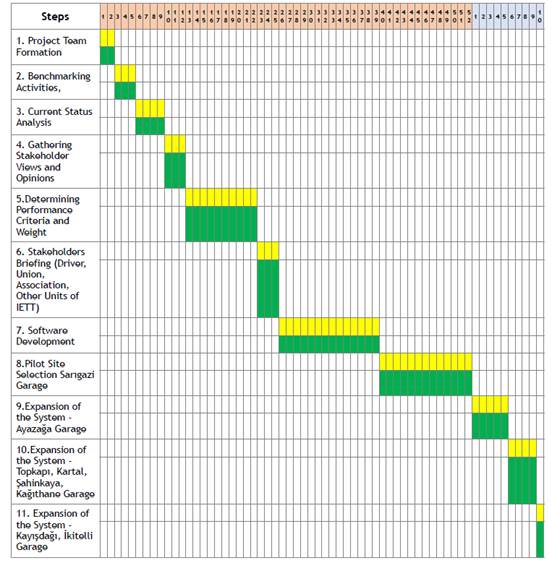
The creation of the "Personnel Competence Points", which is essential for assignments, is planned with performance criteria defined as SMART (SMART = Specific, Measurable, Attainable, Relevant, Timebound). Thus, the resulting score reports produced objective results.
The criteria including the personnel competence points and the scoring ratios are determined as follows: A total of 105 points per month, with 22 points for Completion of a Service on the Bus Line Assigned, 20 for Punctual Arrival and Departure, 18 for Reported Accident Free Days, 18 for No Confirmed Investigation Reports, 9 for No Complaints from Passengers, 8 for Non-Fleet Violations, 5 for Recommendations from Drivers are available for scoring.
In addition, 5 bonus points are added to the performance report in case of extra flex day or vacation is not taken. The certain coefficients have been determined for each case. For example, for Accident free days; 10 if the fault is greater than 0 in a fatal accident, 9 if the fault is greater than 3 in an accident, If the fault is bigger than 3 in material damages, 3.6 points are subtracted from the total accident-free condition score of 18 and the score is written to the driver report card. After the competency score is determined, the software development phase, in which the personnel assignments are chosen by the personel itself, started.
The sample driver score table is shown in Figure
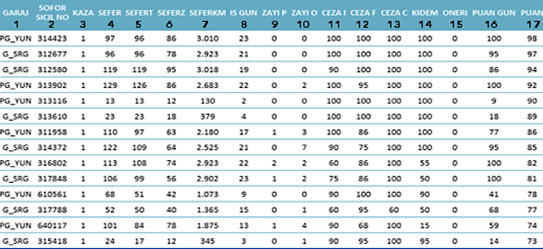
Automatic calculations and job assignments are made in an electronic domain with no human intervention. Special software has been prepared for this. While preparing the software, it is designed to be accessible through any wi-fi spot that the personnel have access to use the program to make their preferences in the system.
It is important to ensure that every personnel who are at different ages and have different information technology literacy level can use the program smoothly, so that the program is designed to be user-friendly during the design process. In addition, a preference guide has been prepared to provide ease of use for the program and to ensure that the selection process is performed correctly and is presented to the personnel under the name of the help file tab in the program interface.
The first pilot of the model was launched in October 2016. In this version, there were 184 bus driver personnel participating on 22 lines with 135 buses in the Sarıgazi Garage of İETT General Directorate. Firstly, a training plan for the driver personnel was established. In these training, the personnel explained the benefits that the new system will have for both personnel and operation. After completing the required preparations for the software, the first choice procedures for the testing purposes were completed by the personnel. As a result of the preferences, 60% of the 184 personnel in Sarigazi Garage were placed in 1st and 2nd choices and the remaining personnel were assigned to the rest of the jobs randomly.
The base scores of the services were also determined with the results of the tests made for the pilot tests. With the determination of the base scores, it became clear which services are more interested in the services, and thus the personnel made it easier to choose according to their own score status during the actual selection process. When the results of the 3-month pilot study of the model were examined, pleasing results were obtained. It has been observed that the performance scores of the majority of the driver personnel in the Sarıgazi Garage increased.
It was determined that the average performance score of 178 personnel in the garage was 91.8 for the 9 months, 93.1 for the 10-month period and 95.8 for the 11-month period (Taşdemir & Ekmekci, 2017, p. 19). The model was applied for 4 months and the decision was made to apply the model to all garages throughout the IETT as a result of the successful results obtained. It was started to be implemented in all garages in February 2017.
The Results of the Model (The data and graphics (figure 3 to 10) in this section are taken from IETT Bus Operations Department, Business Administration in consultations with the experts (09.10.2017).)
The services carried out for the urban public transportation, the quality of the service offered to the passenger is directly proportional to the presentation of the service. No doubt the most important factor in the presentation of the service is "human". Therefore, the satisfaction of the personnel, the commitment to the organization and the understanding of keeping the desire for work at a constant high level is at the top of the issues that are emphasized in business processes. In the new personnel planning model developed by IETT, it is observed that the equity value is very high when the equity sources are used and the benefit cost analysis is done.
As a social added value, increasing personnel satisfaction has been taken as a basis. Increasing personnel satisfaction will provide passenger satisfaction and social wins will be achieved. The graph (Figure
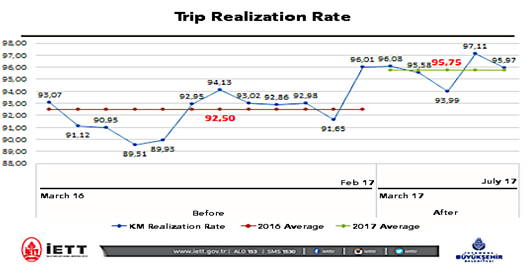
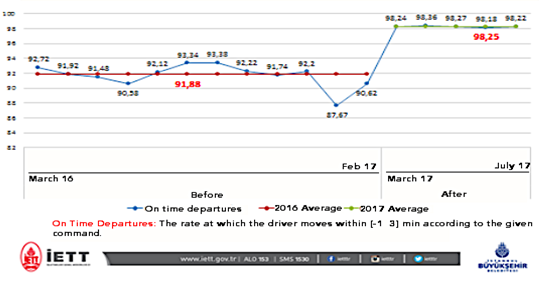
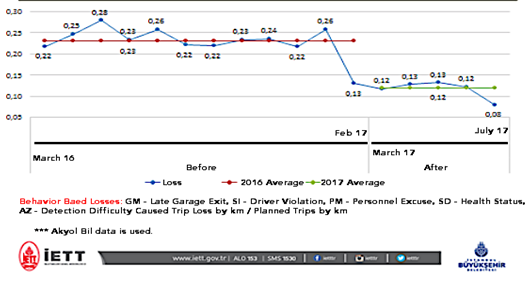
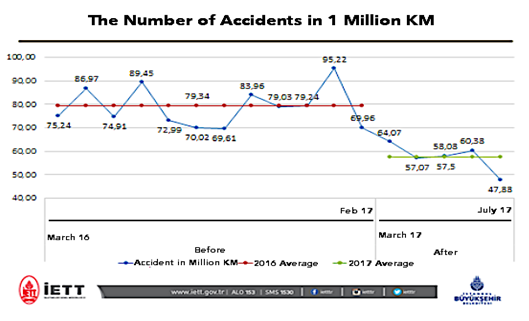
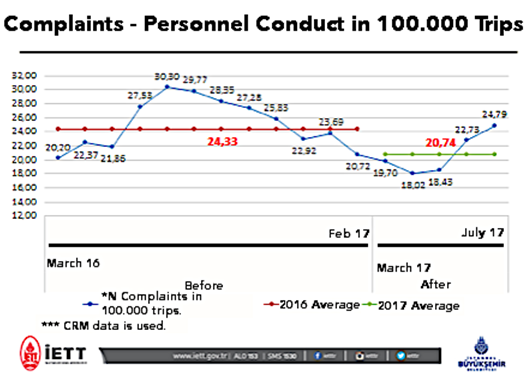
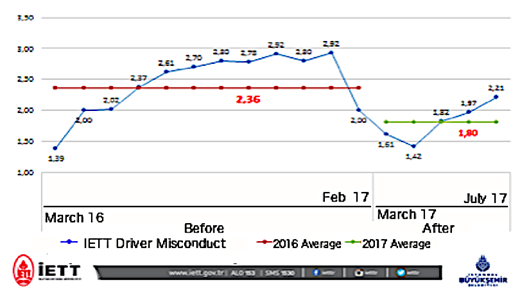
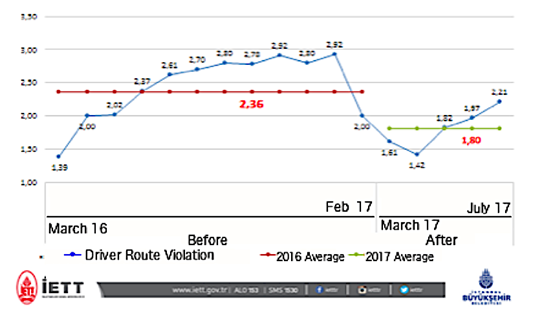
Figure
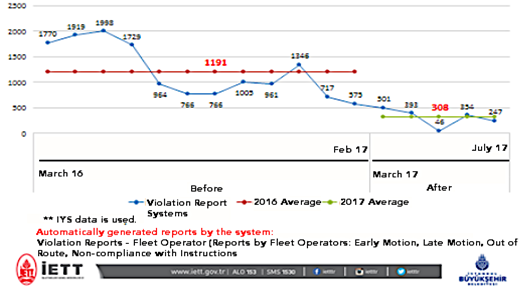
Figure
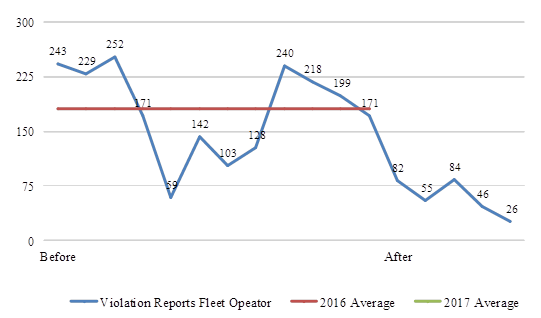
Figure
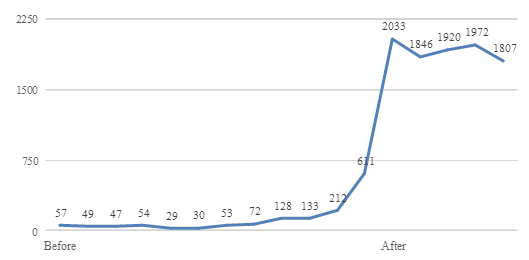
Figure
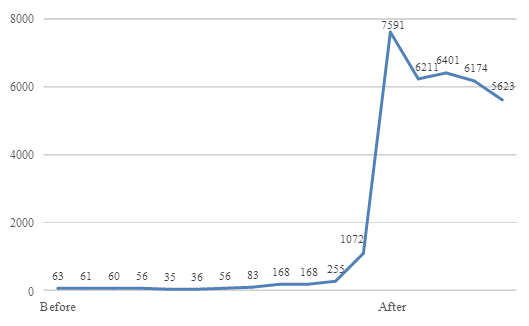
With the execution of the model, awareness on the personnel with high performance has increased, the faulty data in the system have been corrected with the feedback controls, the corporate goals have been spread to the drivers; the cost of doing wrong work has decreased, the customer satisfaction has increased and the motivation of the driver personnel has increased. Significant reductions in the number of accidents and passenger complaints were observed.
The increase in the motivation of the driver personnel also means that the quality of service increases. Because every improvement in the performance criteria is reflected in the passenger at the same time. For example, an improvement in the timing of the movements indicates that the on-time departure of the buses has been respected. The decline in passenger complaints means satisfied with the quality of services offered to passengers. In short, the positive improvements in the individual performance indicators created for the driver personnel also carry the corporate performance to the desired levels.
At the same time, the model has also activated the auto-control impulse. This has led to results such as the completion of the trips on time, the departures of the vehicles at on times, and the decline in accident reports.
The drivers have started to make suggestions to correct the issues that need to be improved in the tasks they have done. Each suggestion made improvements in personnel management system of the institution. It has also been observed that the active use of the system also helps the untreated data generated during the operation to run out of crosschecks.
It is expected that this model will be an example of good practices for public transportation for the other metropolitan cities, due to the undoubtedly successful results. The model has also given IETT a prize in the international field. The Brandon Hall Group Excellence Award Program is known as "Academy Awards" by the industry's most prestigious Learning, Talent, and Business Managers. Excellence Awards are presented to organizations that successfully implement programs, strategies, methods, processes, systems, and tools that deliver measurable results. IETT has been awarded the Best Advance in Workforce Planning and Management category in 2017 with "Employee Based Job Assignment Model" (www.brandonhall.com).
Conclusion
References
- Aguinis, H. (2013). Performance Management (3rd Ed.). Upper Saddle River, NJ: Pearson Prentice Hall.
- Bakan, I., & Kelleroglu, H. (2003). Performans Değerlendirme: Çalışanların Performans Değerlendirme Uygulamalarından Beklentileri Konusunda Bir Alan Çalışması. Süleyman Demirel Üniversitesi The Journal of Economics Administrative Sciences, 8(1), 103-127. Retrieved from http://sablon.sdu.edu.tr/fakulteler/iibf/dergi/files/2003-1-7.pdf
- IETT 2016 Yearly Performance Program (2016). Retrieved from http://www.iett.istanbul/webimage/ files/2016%20FALIYET%20RAPORU.pdf
- Ilıcalı, M., Toprak, T., Ozen, H., Tapkin. S., Ongel, A., Camkesen, N., & Kantarci, M. (2016). Akıcı - Güvenli Trafik İçin Akıllı Ulaşım Sistemleri. Retrieved from http://ww4.ticaret.edu.tr/ulastirma/wp-content/uploads/sites/85/2016/05/AKICI-GÜVENLİ-TRAFİK-İÇİN-AKILLI-ULAŞIM-SİSTEMLERİ.pdf
- Performance. (n.d.) In Türk Dil Kurumu online dictionary. Retrieved from https://sozluk.gov.tr/?kelime=performans
- Siddhart, G., & Nadimpalli, S. (2015). Modern Urbanization: Challenges in Setting up Smart Cities. Cushman & Wakefield Research Report. Retrieved from https://smartnet.niua.org/sites/default/files/resources/SmartCitiesReportCW.pdf
- Smart City Challenge (2016). US Department of Transportation. Retrieved from https://www.transportation.gov/sites/dot.gov/files/docs/Smart%20City%20Challenge%20Lessons%20Learned.pdf
- Taşdemir, F. A., & Ekmekçi, A. (2017). Performance Based Task Assignment Modeling Urban Public Transportation: The Case of IETT. Journal of International Trade, Logistics and Law, 3(1), 11-21.
- Tufan, H. (2014). Akıllı Ulaşım Sistemleri Uygulamaları Ve Türkiye İçin Bir AUS Mimarisi önerisi. [Applications of Intelligent Transport Systems and an ITS Architecture Recommendation for Turkey]. (Master Thesis). Retrieved from https://www.uab.gov.tr/uploads/pages/kutuphane/ae6 c89c3f033ef9.pdf
- Uyargil, C. (2013). Performans Yönetimi Sistemi Bireysel Performansın Planlanması Değerlendirilmesi ve Geliştirilmesi. [Performance management system The Individual Performance Planning, Evaluating and Evoluation]. İstanbul: Beta Basım A.Ş.
- Uysal, S. (2015). Performans Yönetimi Siteminin Tanımı, Tarihçesi, Amaç Ve Temel Unsurlarına Genel Bir Bakış. [Description of Performance Management System, History, An Overview on Purpose and Basic Elements]. Electronic Journal of Vocational Colleges, 5(2), 32-39. Retrieved from http://www.ejovoc.org/makaleler/ekim_2015/pdf/04.pdf
- Waxin, M. F., & Bateman, R. (2009). Public sector human resource management reform across countries: from performance appraisal to performance steering? European Journal of International Management, 3(4), 495-511. DOI:
- Weiland, R. J., & Purser, L. B. (2000). Intelligent Transportation Systems. In Transportation in the New Millennium. (Report no A5009). Retrieved from http://onlinepubs.trb.org/onlinepubs/millnium/00058.pdf
- Why smart cities? (2015). Retrieved on April 11, 2017, from http://www.smart-cities.eu/?cid=1&ver=4
- Yardım, M. S., & Akyıldız, G. (2005). Akıllı Ulaştırma Sistemleri ve Türkiye’deki Uygulamalar Akıllı Ulaştırma Sistemleri ve Türkiye’deki Uygulamalar [Intelligent Transportation Systems and its applications in Turkey]. Intelligent Transportation Systems. In Chamber of Civil Engineers, 6th Transportation Congress. Istanbul. Retrieved from http://www.imo.org.tr/resimler/ekutuphane/pdf/3213.pdf
- Zanella, A., Bui, N., Castellani, A., Vangelista, L., & Zorzi, M. (2014). Internet of Things for Smart Cities. EEE Internet Of Things Journal, 1(1), 1-12. DOI: 10.1109/JIOT.2014.2306328
Copyright information

This work is licensed under a Creative Commons Attribution-NonCommercial-NoDerivatives 4.0 International License.
About this article
Publication Date
20 December 2019
Article Doi
eBook ISBN
978-1-80296-074-7
Publisher
Future Academy
Volume
75
Print ISBN (optional)
-
Edition Number
1st Edition
Pages
1-399
Subjects
Management, leadership, motivation, business, innovation, organizational theory, organizational behaviour
Cite this article as:
Çelikyay*, H. H., & Emecen, A. (2019). Job Assignment Model In Intelligent Transportation Systems: Istanbul Electric Tram Tunnel Administra-Tion. In C. Zehir, & E. Erzengin (Eds.), Leadership, Technology, Innovation and Business Management, vol 75. European Proceedings of Social and Behavioural Sciences (pp. 10-26). Future Academy. https://doi.org/10.15405/epsbs.2019.12.03.2
